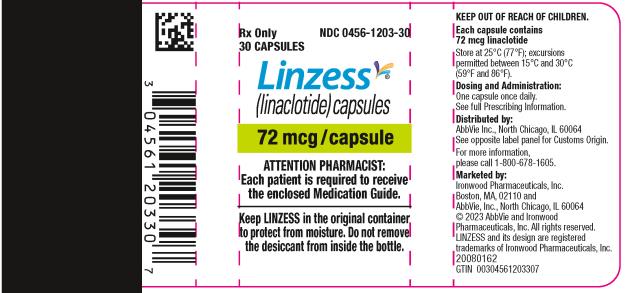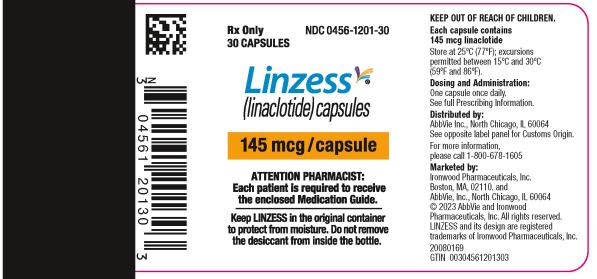Linzess
\Generic name: linaclotide
Drug class: Guanylate cyclase-C agonists
Medically reviewed by A Ras MD.
What is Linzess?
Linzess is a prescription medicine used in adults to treat irritable bowel syndrome with constipation (IBS-C), a type of constipation called chronic idiopathic constipation (CIC). “Idiopathic” means the cause of the constipation is unknown.
It is not known if Linzess is safe and effective in children less than 18 years of age.
Description
LINZESS (linaclotide) is a guanylate cyclase-C (G-CC) agonist. Linaclotide is a 14-amino acid peptide with the following chemical name: L-cysteinyl-L-cysteinyl-L-glutamyl-L-tyrosyl-L-cysteinyl-L-cysteinyl-L-asparaginyl-L-prolyl-L-alanyl-L-cysteinyl-L-threonyl-glycyl-L-cysteinyl-L-tyrosine, cyclic (1-6), (2-10), (5-13)-tris (disulfide).
The molecular formula of linaclotide is C59H79N15O21S6 and its molecular weight is 1526.8. The amino acid sequence for linaclotide is shown below:

Linaclotide is an amorphous, white to off-white powder. It is slightly soluble in water and aqueous sodium chloride (0.9%). LINZESS contains linaclotide-coated beads in hard gelatin capsules. LINZESS is available as 72 mcg, 145 mcg and 290 mcg capsules for oral administration.
The inactive ingredients of LINZESS 72 mcg capsules include: calcium chloride dihydrate, L-histidine, microcrystalline cellulose, polyvinyl alcohol, and talc. The components of the capsule shell include gelatin and titanium dioxide.
The inactive ingredients of LINZESS 145 mcg and 290 mcg capsules include: calcium chloride dihydrate, hypromellose, L-leucine, and microcrystalline cellulose. The components of the capsule shell include gelatin and titanium dioxide.
Mechanism of Action
Linaclotide is structurally related to human guanylin and uroguanylin and functions as a guanylate cyclase-C (GC-C) agonist. Both linaclotide and its active metabolite bind to GC-C and act locally on the luminal surface of the intestinal epithelium. Activation of GC-C results in an increase in both intracellular and extracellular concentrations of cyclic guanosine monophosphate (cGMP). Elevation in intracellular cGMP stimulates secretion of chloride and bicarbonate into the intestinal lumen, mainly through activation of the cystic fibrosis transmembrane conductance regulator (CFTR) ion channel, resulting in increased intestinal fluid and accelerated transit. In animal models, linaclotide has been shown to both accelerate GI transit and reduce intestinal pain.
In an animal model of visceral pain, linaclotide reduced abdominal muscle contraction and decreased the activity of pain-sensing nerves by increasing extracellular cGMP.
What is the most important information I should know about Linzess?
- Do not give Linzess to children who are less than 6 years of age. It may harm them.
- You should not give Linzess to children 6 years to less than 18 years of age. It may harm them.
See the section “What are the possible side effects of Linzess?” for more information about side effects.
Who should not take Linzess?
- Do not give Linzess to children who are less than 6 years of age. Linzess can cause severe diarrhea and your child could get severe dehydration (loss of a large amount of body water and salt).
- Do not take Linzess if a healthcare provider has told you that you have a bowel blockage (intestinal obstruction).
What should I tell my healthcare provider before taking Linzess?
Before you take Linzess, tell your doctor about your medical conditions, including if you:
- are pregnant or plan to become pregnant. It is not known if Linzess will harm your unborn baby.
- are breastfeeding or plan to breastfeed. You and your doctor should decide if you will take Linzess and breastfeed.
Tell your doctor about all the medicines you take, including prescription and over-the-counter medicines, vitamins and herbal supplements.
How should I take Linzess?
- Take Linzess exactly as your doctor tells you to take it.
- Take Linzess 1 time each day on an empty stomach, at least 30 minutes before your first meal of the day. You should also wait 30 minutes before eating a meal if you take Linzess with applesauce or mixed with water.
- If you miss a dose, skip the missed dose. Just take the next dose at your regular time. Do not take 2 doses at the same time.
- Linzess capsules should be swallowed whole. Do not crush or chew Linzess.
- Adults who cannot swallow Linzess capsules whole may open the Linzess capsule and sprinkle the Linzess beads over applesauce or mix Linzess with bottled water before swallowing.
It is not known if Linzess is safe and effective when sprinkled on other foods or mixed with other liquids.
Taking Linzess in applesauce:
- Place 1 teaspoon of room temperature applesauce into a clean container. Open the Linzess capsule and sprinkle all of the Linzess beads onto the applesauce.
- Swallow all of the Linzess beads and applesauce right away. Do not keep the applesauce for later use.
- Do not chew the Linzess beads.
Taking Linzess in water:
- Pour 1 ounce (30 mL) of room temperature bottled water into a clean cup. Open the Linzess capsule and sprinkle all of the Linzess beads into the cup of water.
- Gently swirl the beads and water for at least 20 seconds.
- Swallow all of the Linzess beads and water mixture right away. Do not keep the mixture for later use.
- If you see any Linzess beads left in the cup, add another 1 ounce (30 mL) of water to the beads in the cup, swirl for at least 20 seconds, and swallow right away.
Taking Linzess in a nasogastric or gastrostomy feeding tube:
Gather the supplies you will need to take your Linzess dose. Your doctor should tell you what size catheter tipped syringe you will need for your dose. Ask your doctor if you have any questions about how to give Linzess the right way.
- Open the Linzess capsule and pour all of the Linzess beads into a clean container with 1 ounce (30 mL) of room temperature bottled water.
- Gently swirl the beads and water for at least 20 seconds.
- Remove the plunger from the catheter tipped syringe, and then pour the Linzess bead and water mixture into the syringe and replace the plunger.
- Remove the cap from the syringe, insert the tip of the syringe into the nasogastric or gastric feeding tube and push the plunger all the way in to give the dose.
- If you see any Linzess beads left in the container, add another 1 ounce (30 mL) of water to the beads in the container and repeat the process.
- After giving the Linzess dose, flush the nasogastric or gastrostomy tube with at least 10 mL of water.
What are the possible side effects of Linzess?
Linzess can cause serious side effects, including:
- See “What is the most important information I should know about Linzess?” above.
- Diarrhea is the most common side effect of Linzess, and it can sometimes be severe.
- Diarrhea often begins within the first 2 weeks of Linzess treatment.
- Stop taking Linzess and call your doctor right away if you get severe diarrhea during treatment with Linzess.
Other common side effects of Linzess include:
- gas
- nausea
- stomach-area (abdomen) pain
- swelling, or a feeling of fullness or pressure in your abdomen (distention)
Call your doctor or go to the nearest hospital emergency room right away, if you develop unusual or severe stomach-area (abdomen) pain, especially if you also have bright red, bloody stools or black stools that look like tar.
These are not all the possible side effects of Linzess.
Call your healthcare provider for medical advice about side effects. You may report side effects to FDA at 1-800-FDA-1088.
General information about the safe and effective use of Linzess
Medicines are sometimes prescribed for purposes other than those listed in a Medication Guide. Do not use Linzess for a condition for which it was not prescribed. Do not give Linzess to other people, even if they have the same symptoms that you have. It may harm them.
You can ask your healthcare provider or pharmacist for information about Linzess that is written for health professionals.
How should I store Linzess?
- Store Linzess at room temperature between 68°F to 77°F (20°C to 25°C).
- Keep Linzess in the bottle that it comes in.
- The Linzess bottle contains a desiccant packet to help keep your medicine dry (protect it from moisture). Do not remove the desiccant packet from the bottle.
- Keep the bottle of Linzess tightly closed and in a dry place.
Keep Linzess and all medicines out of the reach of children.
What are the ingredients in Linzess?
Active ingredient: linaclotide
Inactive ingredients:
145 mcg and 290 mcg capsules: calcium chloride dihydrate, hypromellose, L-leucine, and microcrystalline cellulose. Capsule shell: gelatin and titanium dioxide.
72 mcg capsules: calcium chloride dihydrate, L-histidine, microcrystalline cellulose, polyvinyl alcohol, and talc. Capsule shell: gelatin and titanium dioxide.
Label
PRINCIPAL DISPLAY PANEL
- NDC 0456-1203-30
Rx Only
30 CAPSULES
Linzess
(linaclotide) capsules
72 mcg/capsule

PRINCIPAL DISPLAY PANEL
- NDC 0456-1201-30
Rx Only
30 CAPSULES
Linzess
(linaclotide) capsules
145 mcg/capsule


PRINCIPAL DISPLAY PANEL


